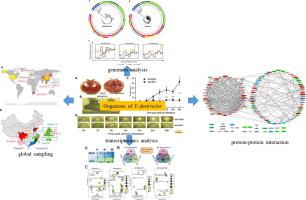Journal of Advanced Research ( IF 10.7 ) Pub Date : 2022-05-04 , DOI: 10.1016/j.jare.2022.04.014 Huoqing Zheng 1 , Shuai Wang 1 , Yuqi Wu 1 , Shengmei Zou 2 , Vincent Dietemann 3 , Peter Neumann 4 , Yanping Chen 5 , Hongmei Li-Byarlay 6 , Christian Pirk 7 , Jay Evans 5 , Fuliang Hu 1 , Ye Feng 2

|
Introduction
Host shift of parasites may have devastating effects on the novel hosts. One remarkable example is that of the ectoparasitic mite Varroa destructor, which has shifted its host from Eastern honey bees (Apis cerana) to Western honey bees (Apis mellifera) and posed a global threat to apiculture.
Objectives
To identify the genetic factors underlying the reproduction of host-shifted V. destructor on the new host.
Methods
Genome sequencing was conducted to construct the phylogeny of the host-shifted and non-shifted mites and to screen for genomic signatures that differentiated them. Artificial infestation experiment was conducted to compare the reproductive difference between the mites, and transcriptome sequencing was conducted to find differentially expressed genes (DEGs) during the reproduction process.
Results
The host-shifted and non-shifted V. destructor mites constituted two genetically distinct lineages, with 15,362 high-FST SNPs identified between them. Oogenesis was upregulated in host-shifted mites on the new host A. mellifera relative to non-shifted mites. The transcriptomes of the host-shifted and non-shifted mites differed significantly as early as 1h post-infestation. The DEGs were associated with nine genes carrying nonsynonymous high-FST SNPs, including mGluR2-like, Lamb2-like and Vitellogenin 6-like, which were also differentially expressed, and eIF4G, CG5800, Dap160 and Sas10, which were located in the center of the networks regulating the DEGs based on protein-protein interaction analysis.
Conclusions
The annotated functions of these genes were all associated with oogenesis. These genes appear to be the key genetic determinants of the oogenesis of host-shifted mites on the new host. Further study of these candidate genes will help elucidate the key mechanism underlying the success of host shifts of V. destructor.
中文翻译:

外寄生螨 Varroa destructor 在其新宿主 Apis mellifera 上卵子发生的基因组特征
介绍
寄生虫的宿主转移可能对新宿主产生破坏性影响。一个显着的例子是外寄生螨Varroa destructor,它已将宿主从东方蜜蜂 ( Apis cerana ) 转移到西方蜜蜂 ( Apis mellifera ),并对全球养蜂业构成威胁。
目标
确定宿主转移的V. destructor在新宿主上繁殖的遗传因素。
方法
进行基因组测序以构建宿主转移和非转移螨的系统发育,并筛选区分它们的基因组特征。通过人工侵染实验比较螨虫的繁殖差异,通过转录组测序寻找繁殖过程中的差异表达基因(DEGs)。
结果
宿主转移和未转移的V. destructor螨虫构成了两个遗传上不同的谱系,在它们之间鉴定了15,362 个高F ST SNP。相对于未转移的螨虫,新宿主A. mellifera上的宿主转移螨虫的卵子发生被上调。宿主转移和非转移螨的转录组早在感染后 1 小时就存在显着差异。DEG 与九个携带非同义高F ST SNP 的基因相关,包括mGluR2-like、Lamb2-like和Vitellogenin 6-like,它们也有差异表达,以及eIF4G、CG5800、Dap160和Sas10位于基于蛋白质-蛋白质相互作用分析的 DEG 调节网络的中心。
结论
这些基因的注释功能都与卵子发生有关。这些基因似乎是宿主转移螨在新宿主上卵子发生的关键遗传决定因素。对这些候选基因的进一步研究将有助于阐明破坏弧菌宿主转移成功的关键机制。


























 京公网安备 11010802027423号
京公网安备 11010802027423号